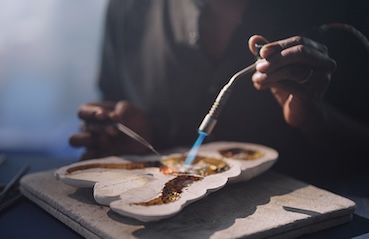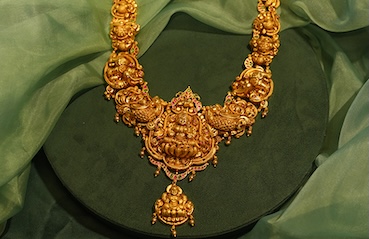Published: 18 May 2018
How gold nanoparticles can make paint change colour

If someone asked you, ‘what is the colour of gold?’, what would you say? After all, gold is a colour too! But when scientists at the University of California, Riverside, pieced nanoparticles of gold together, and then manipulated them, something strange happened. It changed colour. It went from bright blue, to purple, then red.
Like many discoveries and inventions, this was another happy scientific accident. The challenge then was in figuring real world applications for this ‘accident’.
A mosaic of colours
Around 5,000 years ago, gold played an important role in ancient Egyptian mythology, and was prized by pharaohs and temple priests alike.
In time, artists started using gold in their creations, initially as the base metal itself, but then using minute amounts, which when mixed with other elements or glass, created a vivid range of colours. The bright reds visible in stained glass windows in many early European churches and cathedrals used gold nanoparticles. Another great example of the early use of gold nanoparticles was in the creation of the Lycurgus Cup in the 4th century, which changes colour depending on the direction from which light shines on the vessel.
The pressure of perfection
The property of gold that scientists at UC, Riverside found most remarkable, and that could have useful applications, was that sensors made of gold nanoparticles display a different colour depending upon the amount of pressure exerted.
This was first tested on crash test dummies. Sensors could be painted on or wrapped like you would wrap a bandage. A light impact, and you get the colour purple. The point of hardest impact would result in the paint turning red. In other words, not only would it show an impact; it provides a visual representation of the strength of the impact. Car manufacturers could get a lot more information when assessing the impact of a crash when testing new car models.
The future’s bright
Gold’s use in nanotechnology is common because chemically, gold is far more stable than other metals and elements. The research team is now working on ‘reverse engineering’ the process so that from the disassembly that comes with a test impact, the nanoparticles can be designed to self-assemble. This reversible effect will mean that sensors can be re-used multiple times. Imagine that!
A Japanese company has developed technology for the use of gold in paints for vehicles. The paint appears black in areas that are in the shade, and red in illuminated areas. And when the vehicle is in motion, it provides a dynamic effect due to varying light conditions. Other practical applications for gold include:
- Electronics
- Photodynamic therapy
- Therapeutic agent delivery
- Sensors/Probes
- Diagnostics
- Catalysis
The technology has other potential applications, and many more will emerge as knowledge improves. As the world progresses, gold will continue to play an important role in advancing various industries.











